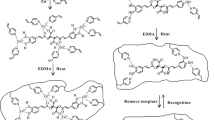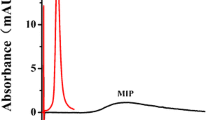Abstract
One of the main challenges in large-scale applications of molecularly imprinted polymers (MIPs) is the significant amount of template needed in polymer preparation. A new strategy based on room-temperature ionic liquids (RTILs) was suggested to solve this problem by reducing the amount of template in the polymerization recipe. The MIP was synthesized with a mixture of dimethyl sulfoxide and RTIL (1-butyl-3-methylimidazolium tetrafluoroborate) as porogen, in which chlorogenic acid (CGA) was used as template, 4-vinylpyridine (4-VP) as functional monomer, and ethylene glycol dimethacrylate (EDMA) as cross-linker. The influence of polymerization variables, including CGA concentrations, and the ratio of 4-VP to EDMA on imprinting effect were investigated comprehensively. Moreover, the properties involving the column permeability, the number of binding sites, and the polymer morphology of the CGA-MIP monoliths were studied thoroughly. The MIP monolith had an excellent column permeability (1.53 × 10−13 m2) and allowed an ultra-fast on-line SPE, which dramatically shortens the separation time (< 10 min) and improves the separation efficiency. At high flow velocity (5.0 mL min−1), 50 μL of the extract from Eucommia ulmoides leaves can be loaded directly on the CGA-MIP monoliths and CGA with high purity can be obtained with a recovery of 89.01 ± 0.05%. As a conclusion, the resulting RTIL-induced approach of preparing MIP may be an effective tool in fabricating MIP in a low-cost way.

ᅟ







Similar content being viewed by others
References
BelBruno JJ. Molecularly imprinted polymers. Chem Rev. 2018. https://doi.org/10.1021/acs.chemrev.8b00171.
Uzun L, Turner APF. Molecularly-imprinted polymer sensors: realising their potential. Biosens Bioelectron. 2016;76:131–44.
Wei ZH, Mu LN, Huang YP, Liu ZS. Imprinted monoliths: recent significant progress in analysis field. TrAC Trends Anal Chem. 2017;86:84–92.
Pan J, Chen W, Ma Y, Pan G. Molecularly imprinted polymers as receptor mimics for selective cell recognition. Chem Soc Rev. 2018;47(15):5574–87.
Ansari S, Karimi M. Recent progress, challenges and trends in trace determination of drug analysis using molecularly imprinted solid-phase microextraction technology. Talanta. 2017;164:612–25.
Han DM, Fang GZ, Yan XP. Preparation and evaluation of a molecularly imprinted sol-gel material for on-line solid-phase extraction coupled with high performance liquid chromatography for the determination of trace pentachlorophenol in water samples. J Chromatogr A. 2005;1100(2):131–6.
Du W, Fu Q, Zhao G, Huang P, Jiao Y, Wu H, et al. Dummy-template molecularly imprinted solid phase extraction for selective analysis of ractopamine in pork. Food Chem. 2013;139(1):24–30.
Lin ZK, Cheng WJ, Li YY, Liu ZR, Chen XP, Huang CJ. A novel superparamagnetic surface molecularly imprinted nanoparticle adopting dummy template: an efficient solid-phase extraction adsorbent for bisphenol A. Anal Chim Acta. 2012;720:71–6.
Du X, Lin S, Gan N, Chen X, Cao Y, Li T, et al. Multi-walled carbon nanotube modified dummy-template magnetic molecularly imprinted microspheres as solid-phase extraction material for the determination of polychlorinated biphenyls in fish. J Sep Sci. 2014;37(13):1591–600.
Yin YM, Chen YP, Wang XF, Liu Y, Liu HL, Xie MX. Dummy molecularly imprinted polymers on silica particles for selective solid-phase extraction of tetrabromobisphenol A from water samples. J Chromatogr A. 2012;1220(2):7–13.
Yilmaz E, Mosbach K, Haupt K. Influence of functional and cross-linking monomers and the amount of template on the performance of molecularly imprinted polymers in binding assays. Anal Commun. 1999;36:167–70.
Sun GY, Zhong DD, Li XJ, Luo YQ, Ba H, Liu ZS, et al. Effect of minimizing amount of template by addition of macromolecular crowding agent on preparation of molecularly imprinted monolith. Anal Bioanal Chem. 2015;407(24):1–12.
Banerjee A, Ibsen K, Brown T, Chen R, Agatemor C, Mitragotri S. Ionic liquids for oral insulin delivery. Proc Natl Acad Sci U S A. 2018;115(28):7296–301.
Itoh T. Ionic liquids as tool to improve enzymatic organic synthesis. Chem Rev. 2017;117(15):10567–607.
Dai C, Zhang J, Huang C, Lei Z. Ionic liquids in selective oxidation: catalysts and solvents. Chem Rev. 2017;117(10):6929–83.
Clarke CJ, Tu WC, Levers O, Bröhl A, Hallett JP. Green and sustainable solvents in chemical processes. Chem Rev. 2018;118(2):747–800.
Wang HF, Zhu YZ, Yan XP, Gao RY, Zheng JY. A room temperature ionic liquid (RTIL)-mediated, non-hydrolytic sol–gel methodology to prepare molecularly imprinted, silica-based hybrid monoliths for chiral separation. Adv Mater. 2006;18(24):3266–70.
Booker K, Bowyer MC, Holdsworth CI, McCluskey A. Efficient preparation and improved sensitivity of molecularly imprinted polymers using room temperature ionic liquids. Chem Commun. 2006;16:1730–2.
Booker K, Holdsworth CI, Doherty CM, Hill AJ, Bowyer MC, Mccluskey A. Ionic liquids as porogens for molecularly imprinted polymers: propranolol, a model study. Org Biomol Chem. 2014;12(37):7201–10.
Bai LH, Chen XX, Huang YP, Zhang QW, Liu ZS. Chiral separation of racemic mandelic acids by use of an ionic liquid-mediated imprinted monolith with a metal ion as self-assembly pivot. Anal Bioanal Chem. 2013;405(27):8935–43.
Li F, Chen XX, Huang YP, Liu ZS. Preparation of polyhedral oligomeric silsesquioxane based imprinted monolith. J Chromatogr A. 2015;1425:180–8.
Golsefidi MA, Es'haghi Z, Sarafraz-Yazdi A. Design, synthesis and evaluation of a molecularly imprinted polymer for hollow fiber-solid phase microextraction of chlorogenic acid in medicinal plants. J Chromatogr A. 2012;1229:24–9.
Miura C, Li H, Matsunaga H, Haginaka J. Molecularly imprinted polymer for chlorogenic acid by modified precipitation polymerization and its application to extraction of chlorogenic acid from Eucommia ulmodies leaves. J Pharm Biomed Anal. 2015;114:139–44.
Tang W, Li G, Row KH, Zhu T. Preparation of hybrid molecularly imprinted polymer with double-templates for rapid simultaneous purification of theophylline and chlorogenic acid in green tea. Talanta. 2016;152:1–8.
Heyman HM, Senejoux F, Seibert I, Klimkait T, Maharaj VJ, Meyer JJM. Identification of anti-HIV active dicaffeoylquinic- and tricaffeoylquinic acids in Helichrysum populifolium by NMR-based metabolomic guided fractionation. Fitoterapia. 2015;103:155–64.
Bagdas D, Etoz BC, Gul Z, Ziyanok S, Inan S, Turacozen O, et al. In vivo systemic chlorogenic acid therapy under diabetic conditions: wound healing effects and cytotoxicity/genotoxicity profile. Food Chem Toxicol. 2015;81:54–61.
Hao Y, Gao R, Liu D, He G, Tang Y, Guo Z. Selective extraction and determination of chlorogenic acid in fruit juices using hydrophilic magnetic imprinted nanoparticles. Food Chem. 2016;200:215–22.
Ji W, Zhang M, Yan H, Zhao H, Mu Y, Guo L, et al. Selective extraction and determination of chlorogenic acids as combined quality markers in herbal medicines using molecularly imprinted polymers based on a mimic template. Anal Bioanal Chem. 2017;409:7087–96.
Deyama T, Nishibe S, Nakazawa Y. Constituents and pharmacological effects of Eucommia and Siberian ginseng. Acta Pharmacol Sin. 2001;22(12):1057–70.
Shahrzad S, Bitsch I. Determination of some pharmacologically active phenolic acids in juices by high-performance liquid chromatography. J Chromatogr A. 1996;741(2):223–31.
González-Pérez S, Merck KB, Vereijken JM, van Koningsveld GA, Gruppen H, Voragen AGJ. Isolation and characterization of undenatured chlorogenic acid free sunflower (Helianthus annuus) proteins. J Agric Food Chem. 2002;50(6):1713–9.
Ban L, Zhao L, Deng BL, Huang YP, Liu ZS. Preparation and characterization of an imprinted monolith by atom transfer radical polymerization assisted by crowding agents. Anal Bioanal Chem. 2013;405(7):2245–53.
Li H, Nie L, Yao S. Adsorption isotherms and sites distribution of caffeic acid-imprinted polymer monolith from frontal analysis. Chromatographia. 2004;60(7–8):425–31.
Li XY, Chen XX, Zhong DD, Huang YP, Liu ZS. Synthesis of imprinted monolithic column with high content of monomers in ionic liquid. RSC Adv. 2014;4:50662–7.
Li H, Li G, Li Z, Lu C, Li Y, Tan X. Surface imprinting on nano-TiO2 as sacrificial material for the preparation of hollow chlorogenic acid imprinted polymer and its recognition behavior. Appl Surf Sci. 2013;264:644–52.
Song X, Li J, Wang J, Chen L. Quercetin molecularly imprinted polymers: preparation, recognition characteristics and properties as sorbent for solid-phase extraction. Talanta. 2009;80(2):694–702.
Sellergren B, Shea KJ. Chiral ion-exchange chromatography: correlation between solute retention and a theoretical ion-exchange model using imprinted polymers. J Chromatogr A. 1993;654(1):17–28.
Huang YP, Zhang SJ, Wu X, Zhang QW, Liu ZS. Preparation and characterization of a low-density imprinted monolithic column. Chromatographia. 2009;70(5–6):691–8.
Umpleby RJ, Baxter SC, Chen Y, Shah RN, Shimizu KD. Characterization of molecularly imprinted polymers with the Langmuir−Freundlich isotherm. Anal Chem. 2001;73(19):4584–91.
Rampey AM, Umpleby RJ, Rushton GT, Iseman JC, Shah RN, Shimizu KD. Characterization of the imprint effect and the influence of imprinting conditions on affinity, capacity, and heterogeneity in molecularly imprinted polymers using the Freundlich isotherm-affinity distribution analysis. Anal Chem. 2004;76(4):1123–33.
Greaves TL, Drummond CJ. Solvent nanostructure, the solvophobic effect and amphiphile self-assembly in ionic liquids. Chem Soc Rev. 2013;42(3):1096–120.
Zabka M, Minceva M, Rodrigues AE. Experimental and modeling study of adsorption in preparative monolithic silica column. Chem Eng Process. 2006;45(2):150–60.
Sing KSW. Reporting physisorption data for gas/solid systems with special reference to the determination of surface area and porosity (provisional). Pure Appl Chem. 1982;54:2201–18.
Funding
This work was supported by the West Light Foundation of the Chinese Academy of Sciences (Grant No. 2017-XBYJRC-002).
Author information
Authors and Affiliations
Corresponding authors
Ethics declarations
Conflict of interest
The authors declare that they have no conflict of interest.
Additional information
Publisher’s note
Springer Nature remains neutral with regard to jurisdictional claims in published maps and institutional affiliations.
Electronic supplementary material
ESM 1
(PDF 383 kb)
Rights and permissions
About this article
Cite this article
Sun, Y.K., Sun, GY., Jia, M. et al. Cost-effective imprinting to minimize consumption of template in room-temperature ionic liquid for fast purification of chlorogenic acid from the extract of E. ulmoides leaves. Anal Bioanal Chem 411, 1261–1271 (2019). https://doi.org/10.1007/s00216-018-1559-8
Received:
Revised:
Accepted:
Published:
Issue Date:
DOI: https://doi.org/10.1007/s00216-018-1559-8




